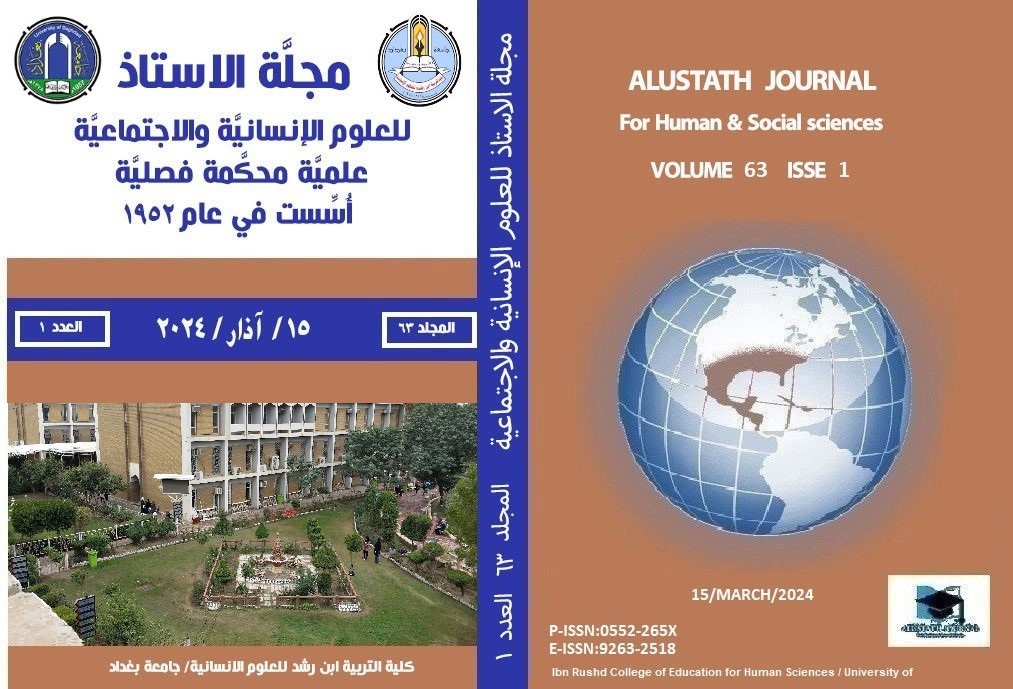The structure of description and the significance of symbols in the narrative discourse of "Radwa Ashour", the novel "The Granada Trilogy" as an example
DOI:
https://doi.org/10.36473/4x9kw140Keywords:
Discourse, description, trilogy, Granada, AshourAbstract
This study deals with the structure of description and the meaning of symbols in the novel “The Granada Trilogy” by Radwa Ashour, whose novel revealed creativity and beauty in description. After studying this novel, it becomes clear to us that the figurative vision in the writer’s speech, including its description and symbolic connotations, took on a formative and intellectual dimension in which “Ashour” searches for ideological connotations, relying in doing so on intellectual connotations, and this is what we observed in the novel “The Granada Trilogy.” So, “Ashour” relied on a cosmetic technique in a spontaneous way in her narratives, perhaps to distance the reader from the false and boring reality, and for this reason realism was included and took its course within the folds of the narrative. As for the symbol, it helped us as readers to think primarily about the meanings of the story, and about defiance and steadfastness on the one hand, and in the face of every attack and every tyrant on the other hand, by taking into account the meanings of the actions and their symbolism, especially since the symbol is a formative part that comes from within the creative writer himself.
Downloads
References
• Adonis, Ali Ahmed Saeed (2005), The Time of Poetry, 6nd edition, Beirut: Dar Al-Saqi.
• Ahmad, Muhammad Fattouh (1984), Symbol and Symbolism in Contemporary Poetry, 3nd Edition, Cairo: Dar Al-Maarif.
• Al-Amami, Muhammad Najeeb (2010), Description in the Narrative Text Between Theory and Action, Tunisia: Muhammad Ali Publishing House.
• Al-Bustani,, Boutros (1987), Mohit Al Muhit, Beirut: Library of Lebanon.
• Al-Jorjani, Ali bin Muhammad bin Ali (2003), al-Tarifat, 2nd edition, Beirut: Dar al-Kutub al-Elamiya.
• Al-Juwayni, Mustafa Al-Sawy (2000), In International Literature: The Story, The Novel, The Biography, Alexandria: Mansha'at Al-Maarif.
• Al-Qadi, Muhammad, and others (2010), Lexicon of Narratives, 1nd Edition, Tunisia: Dar Muhammad Ali for Publishing.
• Al-Tunaji, Muhammad (1993), Al-Mujam al-Mufassal fi al-Adab, 1nd Edition, Beirut: Dar al-Kutub al-Elamiya.
• Ashour, Radwa (2001), The Granada Trilogy, 3nd edition, Cairo: Dar Al-Shorouk.
• Burns, Gerald (2003), The Narrative Term, translated by Abed Khazindar, revised and presented by Muhammad Bariri, No. 368, 1nd edition, Cairo: The Supreme Council for Culture, The National Project for Translation.
• Hilal, Abdel Nasser (2006), Narrative Mechanisms in Contemporary Arab Poetry, 1st edition, Cairo: The Center for Arab Civilization.
• Ibn Jaafar, Qudamah (1995), Criticism of Poetry, investigation: Muhammad Abdel Moneim Khafaji, 1nd Edition, Beirut: Dar Al-Kutub Al-Ilmiya.
• Ibn Manzoor, Jamal al-Din Muhammad ibn Mokram (2005), Lisan al-Arab, 4nd edition, Beirut: Dar Sader.
• l-Qayrawani, Ibn Rasheeq (2000), Al-Omdah in the Industry and Criticism of Poetry, 1nd Edition, Cairo: The International Printing Company.
• Monasi, Habib (2003), The Poetics of the Landscape in Literary Creativity, 1nd Edition, Algeria: Dar Al-Gharb for Publishing and Distribution.
• Murtada, Abdel-Malik (1998), in the theory of the novel, research in narration techniques, the world of knowledge, No. 240, Kuwait: National Council for Culture, Arts and Literature.
• Sabiq, Madiha (2012), the activities of description and its mechanisms in the narrative discourse of "Saeed Boutagine", a memorandum submitted for obtaining a master's degree in modern Arabic literature, Hajj Lakhdar University, Batna, Algeria.
• Sowaidan, Sami (1989), On the Arabic Poetic Text, Methodological Approaches, 1nd Edition, Beirut: Dar Al-Adab.
Downloads
Published
Issue
Section
License
Copyright (c) 2023 Hussein M., Fatima A. Youssof, Mofeed Qomaheh

This work is licensed under a Creative Commons Attribution 4.0 International License.











